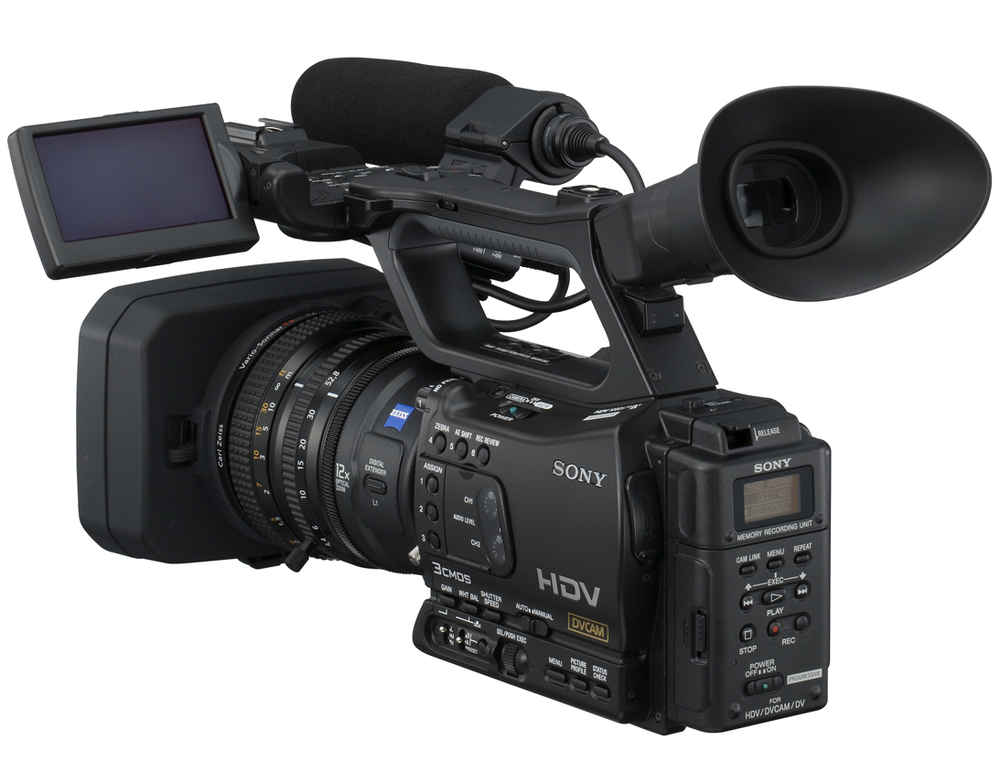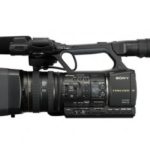
REVIEW – Sony HVR-Z7E
Posted on Nov 2, 2009 by Alex Fice
HD User Magazine’s Editor Adam Garstone Fresh From Reviewing Sony’s EX1 Camcorder Wonders If It’s Only Competitor Is This New HDV Camcorder From Sony’s Prosumer Factory In JapanSony’s new HVR-Z7E is the best handheld HDV camera you can buy. There we are – review over. Job done. I’m off down the pub!
The problem is, someone’s thrown a spanner in Sony’s works, and that someone is…Sony. Just a few months before the launch of this new HDV camera, Sony also launched the PMW-EX1 with a similar form factor and a similar price, but instead of recording HDV onto tape, the EX1 records the new XDCAM EX format onto FLASH based SxS cards. The EX1 is a really good camera – you can read our review in Issue 29 of High Definition or online at www.definitionmagazine.com – so what sets the Z7 apart? Why should you buy one in preference to the EX1?
The first thing you notice about the Z7 is that the lens is removable. It uses a standard 1/3in bayonet and the package includes a Zeiss 12x zoom lens; focal length 4.4mm to 52.8mm – the equivalent of 32mm to 384mm on a 35mm stills camera. The lens has an infinite encoder ring (without end stops) for iris setting, but a proper zoom ring, and a focus ring similar to that on the EX1. Pulled back towards the camera body, this focus ring engages mechanically with the lens. There is a conventional focus scale engraved on the lens barrel and ring works as a nicely weighted, manual focus with end stops. It’s impossible to overemphasise how much better this is than the endless encoder focussing rings found on other cameras (including the Z7’s predecessors). I loved it on the EX1 and it’s a stand out feature on the Z7.
If you really like endless encoders (weirdo!) then pushing the focus ring forwards decouples it from the lens mechanism and gives control over to the camera’s electronics for autofocus operation. Select manual focus in the menu (or, more usefully, assign it to one of the programmable buttons) and the ring in this forward position works as an endless encoder manual focus. The EX1 has a similar arrangement, though it has the more useful ability of allowing you to grab the ring to tweak the autofocus position – leaving the fine focussing to the camera’s electronics. Autofocus on both cameras is a little slow so being able to give it a helping hand on the EX1 is a nice feature. It’s a shame it’s missing from the Z7.
As soon as you have removable lenses, you need back focus adjustment – in other words, a way of adjusting the distance from the lens flange to the sensors. The Z7 comes with a focus chart, and the camera can adjust back focus automatically. Just zoom in on the chart and adjust focus, select the option in the menu and the camera zooms out and adjusts the flange focus as needed. Not only does it work well, but the camera will remember the back focus settings for up to ten compatible (i.e. Zeiss) lenses.
The body of the Z7 is very neat indeed. It houses the three ClearVid CMOS sensors, each with a native resolution of 1440×810 pixels (progressive). The resolution is an interesting choice. HDV samples 1440 pixels horizontally and then up-scales the images to 1920 on playback. Sony have reasoned that they can up-scale in the vertical dimension by the same amount (x1.333) and hence have the same effective resolution and use larger pixels in the sensors, making them more light sensitive. In fact, a rough calculation puts them at not much smaller than the pixels on the ½in, full 1920×1080 sensors on the EX1. Coupled with the Exmor A-D conversion scheme, these sensors have great low light performance for their class (it’s about twice as sensitive as a Z1). It probably doesn’t hurt that the slightly lower native resolution makes the sensors cheaper to manufacture too.
The left side of the body has all the buttons and switches, including a sliding power switch like the EX1. Like the EX1, this slides to the left to turn on the camera, and to the right to enter VCR mode – in the centre the camera is off. Also like the EX1, when trying to turn the camera off, the switch too easily slides through the centre off position. That said, the switch is in a better place than on the EX1. In fact, I found the controls generally much less ‘fiddly’ than those on the Sony’s stable-mate. The right side of the camera only has the HDV tape deck, which is canted out from the body – tapes are inserted from the rear of the camera.
The Z7 comes with an interesting accessory – a Compact Flash (CF) drive can be attached to the rear of the unit. This gives you the option of a tapeless workflow, as well as the tried and trusted tape deck. Video can be recorded to tape or CF or to both simultaneously. CF cards are currently much cheaper than the SxS cards used in the EX1, but it sends a rather confusing message to customers to be using different card formats. In fact, it seems to confuse Sony too – they sent the review unit with an SxS card by mistake!
So, the handling of the Z7 is great, but it’s picture quality is where its stands out from other HDV ‘prosumer’ camcorders. That pixel shifting nonsense used in previous Sony’s (and their competitors) never really gave the sparkling resolution that you want from HD. The Z7 managed to resolve about 850 lines both horizontally and vertically in our tests – not as good as the 1000 lines of the EX1 but for the first time in an HDV camera of this class the images really looked high-def.
Colour rendition was excellent, even shooting in low light, and there was a gorgeous tonality to the images that has always been missing from the Z1 and V1. The cine gamma settings added even more to an already rich image. We test usable dynamic range (from detailed shadow to detailed highlight) and the Z7 scored well into the ‘excellent’ category, though autoexposure tended to burn out the highlights a touch. The only major detractor from image quality is the lens, which exhibits quite a lot of the ‘purple fringing’ chromatic aberration that plagues cheaper glass. The EX1 uses clever signal processing to compensate for this, as do cameras like the Panasonic AG-HPX500 – again, it’s a real shame that this hasn’t been implemented on the Z7.
Sony now have two divisions making handheld, prosumer HD camcorders. The PMW-EX1 has been designed and manufactured in the Atsugi factory which makes the DigiBeta range and the high end HD cameras like the F900, F23 etc. The HVR-Z7E comes from the consumer (and other HDV) camcorder factory in Shinagawa. Perhaps these two divisions are encouraged to compete against each other, after all, it’s better to keep sales in the family. The PMW-EX1 is the better camera. Sure, it’s handling isn’t as good as the Z7 and it’s a bit more expensive, but the image quality is better and you get variable frame rate shooting. However, if you need a tape based camera, and many people do, then the Z7 is the best you can get in this form factor.






